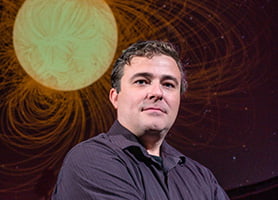Box 19162
Arlington, TX 76019-0162
SHOWCASE
Faster Than a Speeding Photon
In his new book, Ghost Particle, physics Professor Alan Chodos and his co-author, journalist James Riordon, recount the dramatic history of the neutrino.

The neutrino is probably the leading candidate for the most mysterious particle known to exist. As an illustration of how bizarre the neutrino may be, it could even violate the axiom that nothing travels faster than light. The neutrino could be a so-called tachyon, a particle traveling at greater than light speed.i
A faster than light neutrino could have dramatic consequences beyond posing a direct challenge to special relativity. According to relativity, there is no absolute way to fix the order of events connected by a particle traveling faster than light, so ordinary cause and effect might no longer make sense. Also, a particle decay that is forbidden by energy conservation when the particle is at rest could occur if the particle is moving fast enough, if one of the decay products is a tachyon.
That means that there are different outcomes in different frames of reference moving at different speeds. It’s as if a person running through a museum was to see a priceless vase fall from a pedestal and shatter, while the security guard standing next to the exhibit sees no damage. In our normal experience, the vase either breaks or it doesn’t, regardless of how fast each person in the museum is moving. If faster than light tachyons exist, reality breaks down and there’s no way to decide which experience is true, the guard’s or the speedy museum visitor’s.
In the same way, it’s only logical that we should all agree whether or not a particle decay happens. After all, we would be looking at a single event. Neutrinos, or anything else moving faster than light, would potentially lead us to see different outcomes while all looking at the same experiment, depending only on our relative motion. It would shake the foundations of what we think of as reality.
From an experimental standpoint, there are two complementary ways to search for tachyonic behavior. The first is very direct: just measure the velocity. That is, produce a neutrino at one point, detect it a certain distance away, and divide the distance by the time taken to travel from the first place to the second.
The second way involves the mass of the neutrino. Relativity provides a simple equation relating the energy of a particle to its momentum and mass. If the particle travels more slowly than light, its mass is greater than zero. If the particle travels at light speed, like the photon, its mass is zero. If the particle travels at speeds greater than light, the square of its mass is negativeii.
A measurement of the square of the neutrino mass could determine whether or not it is a would move faster than light. Neutrino oscillations give measurements of the differences of the squares of the masses of the three neutrinos. But the differences don’t tell us whether some, or all, of the individual masses squared are positive or negative. For that we need a measurement that looks at other combinations of the neutrino masses.
The OPERA (Oscillation Project with Emulsion-tRacking Apparatus) experiment measured neutrino speed in experiments beginning in 2009. OPERA was a neutrino detector in the Gran Sasso Laboratory, deep under a mountain in Italy about 730 km from the CERN laboratory in Geneva. OPERA’s main purpose was to study the tau neutrino, but they also had data of muon neutrinos that had been produced at CERN and then traveled to Gran Sasso where they were detected. The production time and detection time were recorded, and the distance between the two laboratories was accurately known using GPS.
The big surprise, when OPERA announced their results in September of 2011, was that the neutrinos were traveling significantly faster than the speed of light. CERN Research Director Sergio Bertolucci made the announcement in a web-cast conference with invitations extended to members of the news media. The event short circuited the normal scientific process, which involves peer review that typically provide checks on imprudent announcements and potentially shoddy research. If true, the OPERA measurements showed that neutrinos coming from CERN would have outpaced a photon by about 60 billionths of a second. While this may seem small, it corresponds to a large negative mass squared, and shattered the universal speed limit. If true, it meant neutrinos would have beaten light over the course of the 730-kilometer trip by 18 meters, roughly a fifth the length of a football field. The announcement captured headlines around the world and caused an uproar in the scientific community.iii
The OPERA press conference unleashed a flood of papers from scientists around the globe. Many offered explanations of how the neutrino could perform this remarkable feat. Others purported to prove that the neutrino could not be a tachyon because of conflicting experimental measurements. Some, like a paper by Boston University’s Andrew Cohen and Sheldon Glashow published in Physical Review Lettersiv, relied on calculations and theory to throw cold water on the faster-than-light neutrino claims. Cohen and Glashow argued that if neutrinos go faster than the speed of light, they will very quickly lose energy by radiating electron-positron pairs.
“Then it’s straightforward to calculate the rate,” said Glashow, “and the rate is very fast so that the neutrinos . . . could not travel the several hundred kilometers between CERN and the detector, they probably couldn’t travel more than a hundred meters, or ten meters,” before radiating away their energy. “It was definitely a nail in the coffin,” for the OPERA claim, said Glashow, “until the real nail was found. Anyway, they don’t go faster than the speed of light.”
Yet other papers dwelt on the philosophical difficulties, such as the possibilities of time travel, and the upending of the relation between cause and effect that would be allowed by tachyonic behavior.
Finally, the matter was resolved in the spring of 2012 when OPERA discovered a loose cable in their apparatus, which had contaminated their timing data. When the problem was fixed, the discrepancy between the neutrino velocity and the speed of light disappeared, (and the wisdom of the conventional peer review process was bolstered).
This did not mean that the neutrino was definitively proved not to be a tachyon. What it did prove is that, if it’s a tachyon, its deviation from the speed of light was too small to be measured by OPERA.
i Alan Chodos, Avi I. Hauser and V. Alan Kostelecký, “The Neutrino as a Tachyon”, Physics Letters 150B (1985), 431.
ii In the case of negative mass squared, the mass itself is a so-called “imaginary number” involving the square root of negative one – but this does not make it unacceptable physically
iv A.G. Cohen and S.L. Glashow, Phys. Rev. Lett. 107, 181803 (2011)
READ MORE

Investigating Earth’s ionosphere-thermosphere
A space physicist at UTA is playing a key role in NASA’s Geospace Dynamics Constellation mission aimed at improving our understanding of the planet’s ionosphere-thermosphere (I-T) system.

Quantifying the benefits of roadside vegetation
Construction management Assistant Professor Kyeong Rok Ryu is helping cultivate a better-looking Texas by creating best practices for roadside vegetation.

Evaluating smart traffic signal design
Civil engineer Pengfei “Taylor” Li hopes to make traffic signals smarter with new simulation techniques and big data.